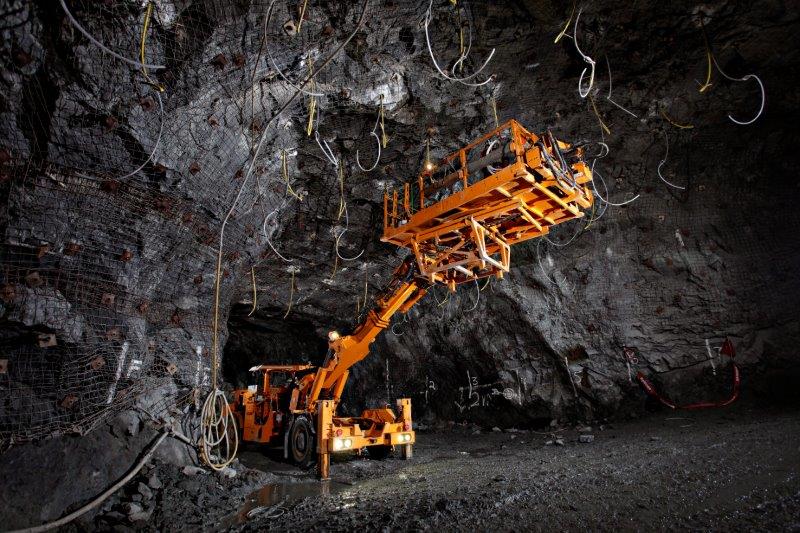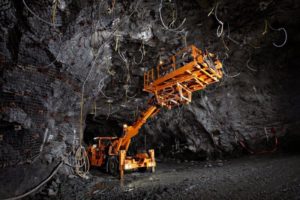MacLean Engineering – interest in electric mining vehicles turning into purchase orders

Battery electric MacLean 975 Omnia Bolter 3
by Kathrine Moore

Headquartered in Collingwood, Ontario, and serving some 23 countries, MacLean Engineering has been developing underground mining equipment for over 45 years. Family-owned MacLean Engineering has a large manufacturing footprint. Besides the main offices, the company has an 65,000 square foot facility in Collingwood, an 60,000 square foot facility in Owen Sound and a 85,000 square foot facility in Barrie, all in Ontario.
In Canada, MacLean Engineering has offices in Sudbury, Ontario; Thompson, Manitoba; Creighton, Saskatchewan and Val-d’Or, Québec. They also have branches in Mexico, Peru, South Africa and Australia. The company has a presence in just about every mining camp globally and employs ~600 individuals.
After returning from successfully presenting at a busy PDAC, Anthony Griffiths, Product Manager Fleet Electrification, Mining Division at MacLean Engineering, spoke to Resource World about the changing mining equipment industry.
Griffiths said, “Three years ago we started out battery electrifying one of our mining vehicles, a MacLean bolter.  That started us out on this path that we are on now – full fleet electrification.” He said that interest in battery operated mining vehicles has grown since. “This year, many companies want to come and see a demo or have a demo done on their site. We have just sold a unit to Vale, in the Sudbury basin. We are starting to see interest translate into purchase orders. After PDAC this year, we have been extremely busy responding to interest and providing quotes.”

Maclean Engineering provides ground support, utility vehicles and a suite of equipment they call ore flow facilitation which is used primarily in block caving mining. They also solve high hang-up problems and reduce oversize after blasting. Griffiths said, “We don’t do big haul trucks or scoops but we do everything else in the mining business.”
Griffiths said interest is coming from mining jurisdictions worldwide, “Just yesterday we had an inquiry from Mexico about acquiring battery powered equipment.” The company recently did a presentation to an international group as a direct result of PDAC. “They wanted to see our battery system. We are anticipating a very busy year and it looks like next year will be even busier based on the amount of requested quotes,” said Griffiths.
“We now have six units operating with another three to be delivered at the end of the month and we have another fourteen units in manufacturing, eleven of which are sold. To date our technology used underground has been very successful,” added Griffiths.
The company is innovating on a fleet-wide scale. Griffiths explained, “We are currently electrifying all of our eight-foot wide equipment. The battery gives us the ability to tie in vehicle monitoring and telemetry services and vehicle health asset management. ”
Eight feet is the standard width of an underground machine in the mining industry. “Currently that is the one we are seeing the most demand for. In some cases and jurisdictions some companies are going a little narrower. So we also have a six-foot wide fleet of equipment that we will start to electrify in 2019,” said Griffiths.
Griffiths described MacLean Engineering’s approach to battery propulsion. “When we started out on this path we looked at what was available and what we felt would best provide our customers with a superior product. Instead of buying a supplier’s whole solution to battery propulsion, we hired a mobile propulsion engineering company called Medatech. They scoured the market and came back with a recommendation and a design based on the best components available globally. They sourced battery chargers from one company, the batteries from another and the propulsion motors and drive motors from yet another company. The battery sector is changing so fast and innovating so quickly that we didn’t want to get stuck with yesterday’s technology, we wanted the best we could find.”
“Our battery is based on a modular system,” said Griffiths. “Our supplier is a company out of Germany. They assemble the batteries and the chemistry is a blend of NMC and LTO technologies. NMC stands for lithium ion nickel, manganese, cobalt, and LTO stands for Lithium Titanate Oxide (LTO). These chemistries provide best in class lifecycle, energy density and energy discharge capabilities. What sets us apart with our particular design is that we have the ability to cool the battery with an internal liquid cooling battery management system. We also don’t swap out the battery. We put the battery in the vehicle for the life of the machine. Currently our life cycle charging on the battery indicates that we get a minimum of 6,800 full charges, from empty to full. Testing we have done on units in the field validates that MacLean customers are going to get, in some cases, as much as 10 to 12 years of life out of these batteries.”
“Another thing that separates us from our competitors,” explained Griffiths, “is that with the battery going in and staying on the unit we decided to do all our charging on board. What that means is, you just have to pull up to an existing underground outlet and our machine will plug in. So you can literally recharge anywhere in the mine where there is an existing outlet. That provides a great deal of flexibility to the mine operator. You don’t have to install charging walls, a battery swap-out base or other infrastructure. Our equipment can show up on site and go to work underground immediately. That has been a significant advantage for us and differentiates us from other people in the business. Our system is designed to go anywhere from 360 to 1,000 volts so whether the vehicle goes to Mexico or Canada, South Africa or Australia it is compatible with the electric grid. We wanted our equipment to be highly adaptable and ready to go as soon as it gets to the site.
“As for the drive train, it was designed by Medatech Engineering, located here in Collingwood as well. We have worked with them on a number of engineering projects and they are global leaders in the field of battery electric propulsion systems for underground mining. They were a good fit.
The motors and motor controllers are manufactured in Quebec by a company called TM4.
One of MacLean Engineering’s biggest clients is Goldcorp. At their Borden Lake Mine in northern Ontario they mandated from the start that it would be a non-diesel mine. MacLean Engineering supplied the first five, all battery vehicles to the site: two scissor bolters, a scissor lift and two cassette carriers. Griffiths said, “We are also providing a grader and we just received a second order from them for another nine units. So the battery system has proved itself and we have been rewarded with that second order. When all is said and done we will have 15 battery operated units operating at that mine by the end of the year.”
As to future developments, Griffiths said, “We are looking at innovating our existing fleet to what the market is telling us they need. We do have a low profile package but we have not electrified that yet. We are working with potash companies and people who use low profile equipment. We are certainly looking at electrifying our low profile equipment and finding a battery package for that.”
“And we are looking at a several pieces of equipment that we normally wouldn’t do, but because of our battery technology we have been asked to consider electrifying underground graders and other types of units,” added Griffiths. “A company came to us and asked, ‘could you take the diesel components out of our grader and convert it to battery propulsion?’ We did that and it is just being tested this week to be delivered at the end of the month. We are excited about that; we have created another product as a result of our commitment to developing and commissioning battery technology in underground mining.”
Battery commodities are hot right now. “We are using the batteries to power the equipment that is mining the commodities needed to make more batteries. It is a beautiful full cycle situation for us,” said Griffiths. “There is a demand for nickel, cobalt, zinc, lithium and copper. In order to have a cleaner work environment and reduce your ventilation energy demands, you need those commodities that go into battery technology. It is a very good opportunity for us right now.”
